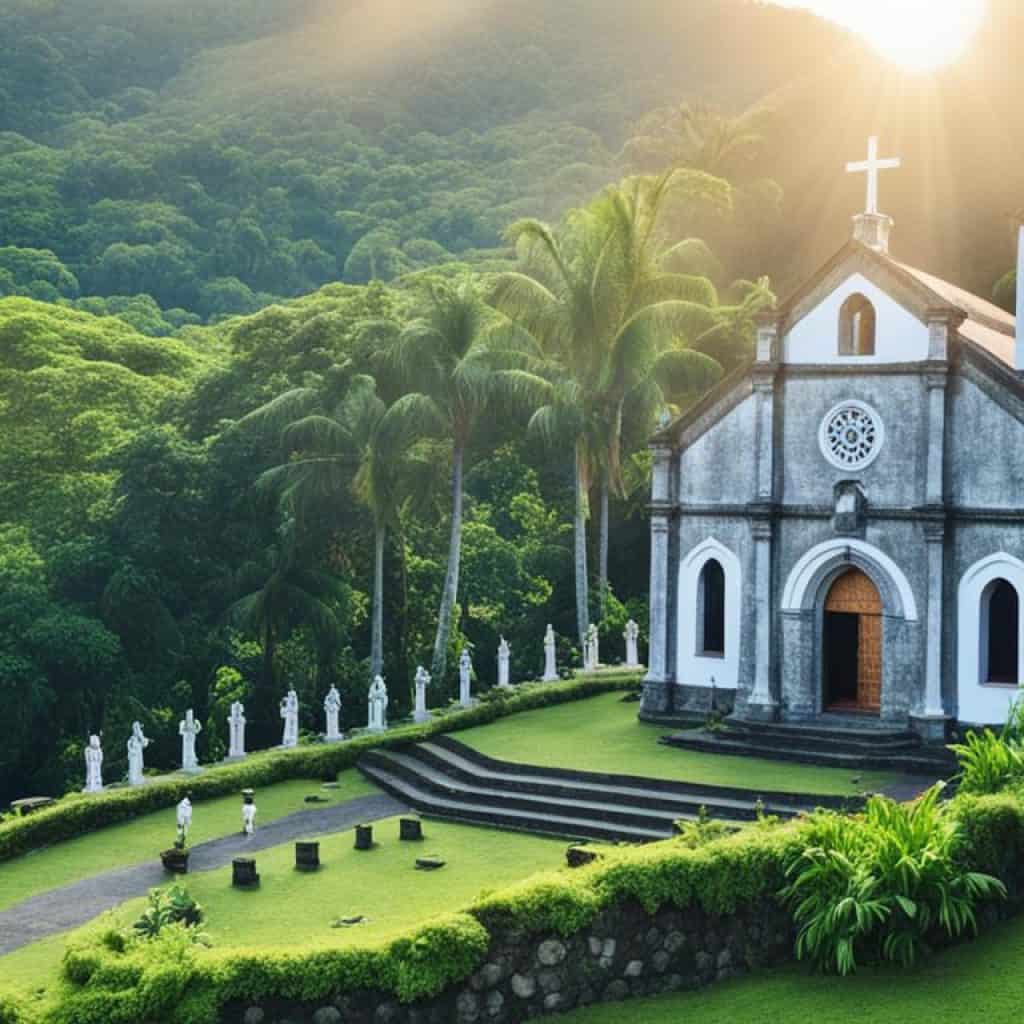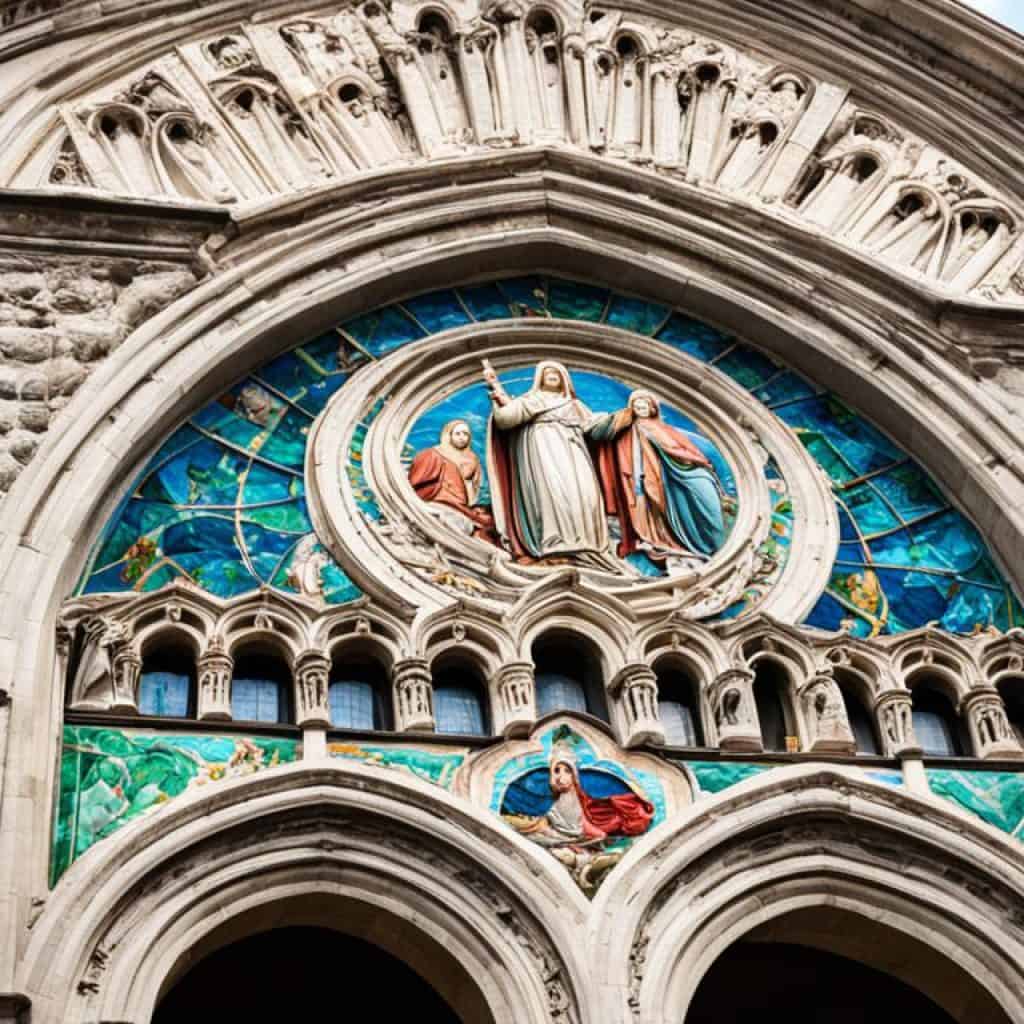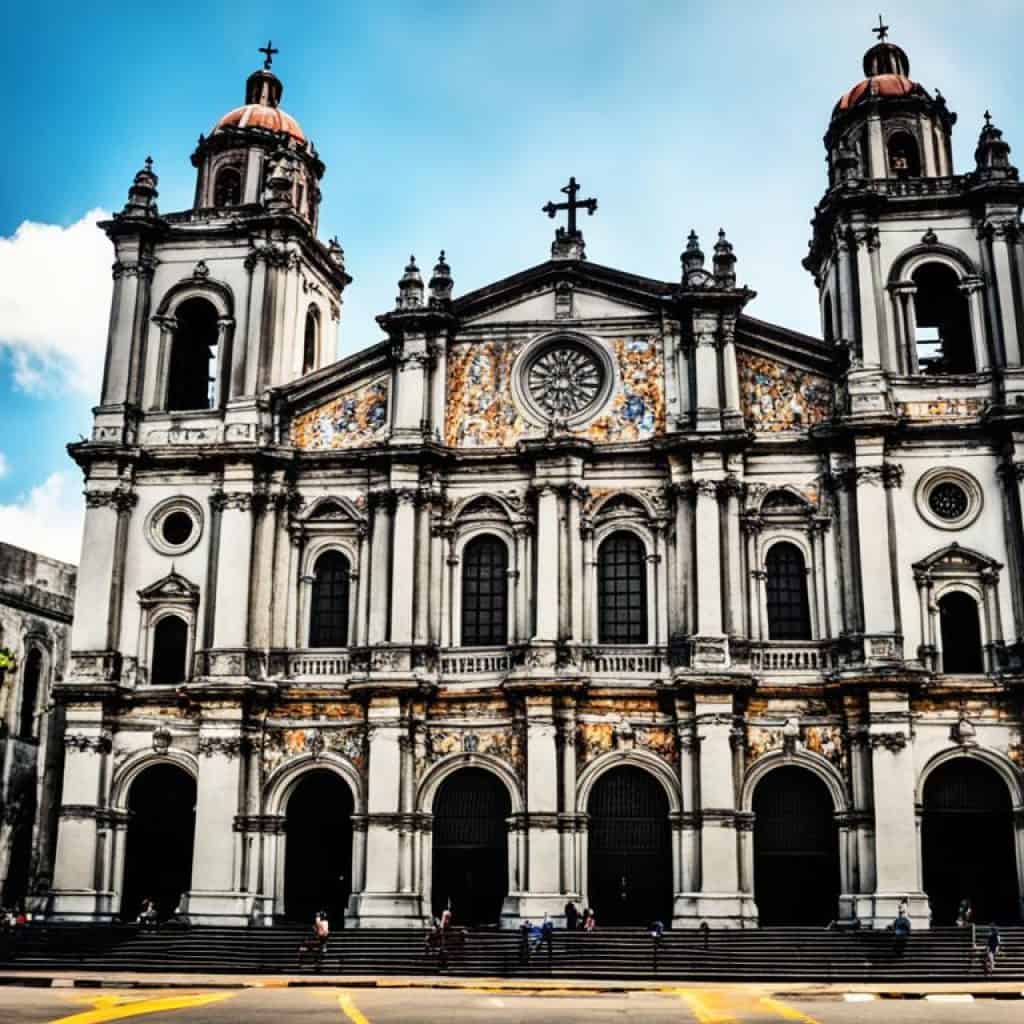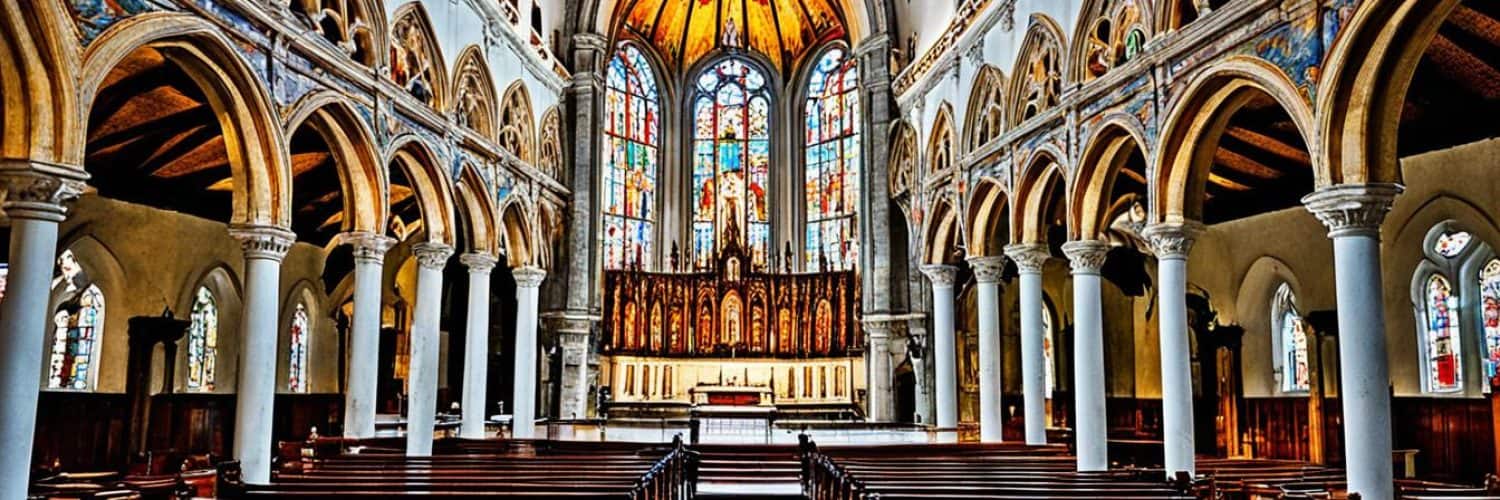The Philippines is home to a multitude of historical churches that have become iconic landmarks in the country. From their stunning architecture to their religious significance, these famous churches offer a window into the rich culture and history of the Philippines. But have you ever wondered which church is the most visited or considered the best?
Get ready to embark on a journey through some of the top churches in the Philippines, as we explore their unique features and learn about their historical importance. Whether you’re a history buff, an architecture enthusiast, or simply curious about the religious heritage of the Philippines, these guided tours of famous churches will leave you in awe.
Key Takeaways:
- The Philippines is home to many famous historical churches that showcase the country’s rich culture and history.
- These churches serve as important landmarks and are known for their stunning architecture and religious significance.
- Guided tours of famous churches in the Philippines provide a deeper understanding of the country’s heritage.
- Whether you’re interested in history, architecture, or religious devotion, these churches are worth exploring.
- Stay tuned as we delve into the top churches in the Philippines and discover their unique features.
Mt. Carmel Chapel (Batanes)
Located in the picturesque province of Batanes, Mt. Carmel Chapel, also known as Tukon Church, is a stunning stone church that captivates visitors with its traditional stone-house design and breathtaking views. The chapel stands on the smallest island province in the Philippines and offers a peaceful sanctuary amidst the natural beauty of Batanes.
While being a popular choice for private wedding celebrations, Mt. Carmel Chapel also holds Sunday masses despite currently undergoing construction due to a recent typhoon. The resilience of this stone church is a testament to the devotion and strength of the local community.
As you step into the chapel, you’ll be enveloped by a sense of tranquility and reverence. The stone walls and arches, reminiscent of Batanes’ traditional stone houses, exude an air of timeless beauty and cultural heritage. The chapel’s serene atmosphere, combined with the picturesque backdrop of Batanes, the Pacific Ocean, and the West Philippine Sea, creates a truly memorable experience.
Stone Architecture and Natural Beauty
The stone-house design of Mt. Carmel Chapel showcases the rich architectural heritage of Batanes. The use of local stone materials not only adds to the chapel’s beauty but also integrates it harmoniously with the surrounding landscape. As you explore the chapel grounds, you’ll discover lush gardens and pathways that enhance the overall ambiance, providing a peaceful setting for prayer, reflection, or a private wedding celebration.
A Haven for Private Wedding Celebrations
Mt. Carmel Chapel has become a sought-after venue for private wedding celebrations in Batanes. Couples are drawn to its enchanting beauty, romantic atmosphere, and breathtaking views. Saying “I do” in this idyllic setting creates lasting memories against the backdrop of Batanes’ natural splendor and the stone church’s timeless charm.
Step into the beauty of Mt. Carmel Chapel in Batanes and experience the serenity of this stone church amidst breathtaking natural surroundings.
Exploring Batanes: Discovering Tukon Church
While visiting Batanes, a journey to Mt. Carmel Chapel is a must for travelers seeking to immerse themselves in the culture, history, and natural beauty of the Philippines. The stone church’s serene atmosphere and picturesque views provide a serene escape from the hustle and bustle of daily life. Whether attending a Sunday mass, admiring the stone architecture, or participating in a private wedding celebration, Tukon Church is sure to leave a lasting impression on your heart.
Binondo Church (Manila)
Welcome to Binondo Church, also known as the Minor Basilica and National Shrine of Saint Lorenzo Ruiz! Situated in the heart of Binondo, Manila, the oldest Chinatown in the world, this historic church holds a significant place in the Philippines’ cultural and religious landscape. Established in 1596, Binondo Church was built with a purpose – to guide and assist the Chinese community in their conversion to Christianity.
Throughout its illustrious history, Binondo Church has been witness to the trials and triumphs of the Filipino-Chinese community. The church suffered severe damage during World War II but was faithfully restored to its former glory. Today, it stands as a testament to resilience, faith, and unity.
“Binondo Church is not just a religious sanctuary; it is a symbol of the harmonious fusion of Chinese and Filipino cultures.”
One of the most striking features of Binondo Church is the statue of Saint Lorenzo Ruiz, a Chinese convert to Christianity who became the Philippines’ first martyr. The statue stands as a powerful representation of faith and cultural heritage, attracting visitors from all walks of life.
As you step inside Binondo Church, you’ll be immersed in a serene and sacred atmosphere. The majestic architecture, adorned with intricate details, serves as a visual delight and a testament to the craftsmanship of its builders.
Binondo Church Highlights
| Location | Binondo, Manila, Philippines |
|---|---|
| Year Established | 1596 |
| Designation | Minor Basilica and National Shrine |
| Significance | Oldest Chinatown in the world |
| Architectural Style | Baroque |
No visit to Manila’s Chinatown is complete without a stop at Binondo Church. Immerse yourself in the vibrant atmosphere, explore the intricate details of the architecture, and take a moment of reflection amidst the bustling energy of the oldest Chinatown in the world.
Caleruega Church (Batangas)
Located in the picturesque province of Batangas, Caleruega Church, also known as the Transfiguration Chapel, offers a tranquil retreat place for those seeking solace and spiritual rejuvenation. The church, built in 1995, is renowned for its stunning architecture and captivating views of the surrounding hills, farmland, and the majestic Batulao Mountains.
Caleruega Church is not only a place of worship but also a popular choice for couples seeking a fairytale wedding. Its serene ambiance and natural beauty create a romantic setting for exchanging vows and celebrating love. The Transfiguration Chapel, with its charming design and idyllic location, provides an enchanting backdrop for a truly memorable wedding ceremony.
For those visiting Tagaytay, Caleruega Church is conveniently located nearby, making it an ideal stop for tourists who want to explore the region’s natural wonders and immerse themselves in its rich cultural heritage.
Discover the oasis of peace and unparalleled beauty that is Caleruega Church, where spiritual serenity and breathtaking surroundings unite.

Features of Caleruega Church:
- Breathtaking views of hills, farmland, and the Batulao Mountains
- Tranquil retreat place for spiritual rejuvenation
- Romantic wedding venue with an enchanting atmosphere
- Conveniently located near Tagaytay for easy access to other tourist attractions
Visiting Information |
|
|---|---|
| Location | Brgy. Kaylaway, Batulao, Nasugbu, Batangas |
| Opening Hours | 8:00 AM – 5:00 PM (Monday to Sunday) |
| Contact Information | Phone: +63 918 962 3016 |
| Website | https://www.caleruega.org/ |
Baclayon Church (Bohol)
Baclayon Church, located in the enchanting island province of Bohol, is a true testament to the Philippines’ rich cultural heritage. Built in 1727, this historic Catholic church is one of the oldest in the country, made entirely of original materials. It holds great religious significance and has been declared as both a National Cultural Treasure and a National Historic Landmark.
Surrounded by the natural beauty of Bohol, Baclayon Church offers visitors a unique experience. The province is renowned for its stunning diving spots that captivate underwater adventurers with vibrant marine life and breathtaking coral reefs. Additionally, the iconic Chocolate Hills, Bohol’s famous geological formations, create a mesmerizing landscape that is sure to leave visitors in awe.
Inside Baclayon Church, a small museum awaits, showcasing a collection of religious antiques dating back to the 16th century. This intriguing display offers a glimpse into the region’s religious and cultural history, allowing visitors to appreciate the significance of the church within the context of Bohol’s rich heritage.
Inspiring and awe-inspiring, Baclayon Church stands as a beacon of faith and history in the heart of Bohol. Its centuries-old architecture, accompanied by Bohol’s captivating natural wonders, creates a truly unforgettable experience for all who visit.
Fascinating Facts about Baclayon Church
- Baclayon Church is made with coral stones and its walls are estimated to be around 1.5 meters thick, making it resilient to both time and natural disasters.
- The interior of the church features beautiful hand-painted ceiling murals and intricately-carved wooden furniture, showcasing the craftsmanship of the time.
- Despite its long history, Baclayon Church still holds regular religious services, welcoming both locals and tourists to participate in the celebration of faith.
- Exploring Baclayon Church is a unique opportunity to deepen your understanding of the Philippines’ colonial past and the enduring influence of Catholicism.
Baclayon Church in Bohol
| Location | Year Built | Materials | Recognitions |
|---|---|---|---|
| Baclayon, Bohol | 1727 | Coral stones | National Cultural Treasure, National Historic Landmark |
Barasoain Church (Bulacan)
Barasoain Church, also known as Our Lady of Mount Carmel Parish, is a Roman Catholic church located in Malolos, the capital province of Bulacan. The church is steeped in historical significance and holds a special place in the hearts of Filipinos.
Constructed in the late 17th century, Barasoain Church has witnessed three pivotal events in Philippine history. It served as the venue for the First Philippine Congress in 1898, where the country’s first constitution, known as the Malolos Constitution, was drafted. The church was also witness to the inauguration of the First Philippine Republic, marking the birth of democracy in the Philippines.
“Barasoain Church stands as a testament to the resilience and determination of the Filipino people in their pursuit of independence and freedom.”
The church complex includes a museum that beautifully illustrates the historical significance of these events through artifacts, exhibits, and interactive displays. Visitors can immerse themselves in the rich history and learn about the struggles and triumphs of the Filipino people during this crucial period.
Aside from its historical significance, Barasoain Church also stands as a remarkable architectural gem. Its intricate facade, adorned with ornate carvings and intricate details, showcases Spanish colonial influences and creates a sense of grandeur and awe.
Visiting Barasoain Church is a must for anyone interested in Philippine history, culture, and architecture. It offers a unique opportunity to delve into the past and gain a deeper understanding of the nation’s journey towards independence.
Highlights of Barasoain Church:
- Historical significance as the site of the First Philippine Congress, the Malolos Constitution, and the First Philippine Republic
- Architectural beauty with its intricate facade and Spanish colonial influences
- Museum showcasing artifacts and exhibits that depict the historical events
| Barasoain Church (Bulacan) | Highlights |
|---|---|
| Location | Malolos, Bulacan |
| Religious Affiliation | Roman Catholic |
| Historical Significance | Site of the First Philippine Congress, the Malolos Constitution, and the First Philippine Republic |
| Architectural Style | Spanish colonial |
| Attractions | Museum showcasing historical artifacts and exhibits |
| Visiting Hours | Open daily from 8:00 AM to 5:00 PM |
| Entrance Fee | PHP 20 |
Santa Maria Church (Ilocos Sur)
Santa Maria Church is a stunning Baroque-style church located in Ilocos Sur, a province renowned for its heritage sites and picturesque cobblestoned streets in Vigan City. This magnificent church is a UNESCO World Heritage Site that beautifully showcases the rich architectural heritage of the Philippines.
Built in 1769 on top of a hill, Santa Maria Church offers breathtaking panoramic views of the surrounding area, creating a serene and awe-inspiring atmosphere for visitors. The church’s brick-and-mortar architecture exemplifies the grandeur and intricacy of Baroque churches, with its ornate details and impressive facade.
One of the highlights of Santa Maria Church is the sculpture of Our Lady of the Assumption, which is perched atop a tree within the church grounds. This statue holds great religious significance and adds to the overall charm and spiritual ambiance of the church.
Visiting Santa Maria Church allows travelers to immerse themselves in the rich history and cultural heritage of Ilocos Sur. The church stands as a testament to the deep faith and devotion of the Filipino people, as well as a symbol of the region’s architectural and artistic excellence.

| Location | Architectural Style | Year Built |
|---|---|---|
| Ilocos Sur, Philippines | Baroque | 1769 |
Molo Church (Iloilo)
Molo Church, also known as St. Anne Parish Church, is a Gothic-Renaissance Church located in Iloilo, a province known for its Spanish colonial churches and ancestral houses. With its architectural beauty and cultural significance, Molo Church is a must-visit destination in the Visayas region of the Philippines.
Feminist Church with a Remarkable Design
What sets Molo Church apart is its feminist design, making it a standout among other churches in the country. The church is home to 16 statues of female saints arranged in two rows, celebrating the important role of women in the Catholic faith. This unique feature makes Molo Church a symbol of empowerment and gender equality.
A Cultural and Heritage Site
Molo Church holds great cultural and historical significance in the Visayas region. As one of the oldest churches in the Philippines, it has witnessed centuries of religious devotion and community gatherings. Its stunning Gothic-Renaissance architecture, with intricate details and towering spires, is a testament to the craftsmanship of the past.
“Molo Church stands as a testament to the rich heritage and deep faith of the Filipino people. Its feminist design and architectural grandeur make it a fascinating destination for history enthusiasts and spiritual travelers alike.”
Exploring Visayas Tourist Spots
Molo Church is just one of the many captivating attractions the Visayas region has to offer. From pristine beaches to colonial-era towns, Visayas is a treasure trove of natural wonders and cultural landmarks. Plan your itinerary to explore other Visayas tourist spots such as the Chocolate Hills in Bohol or the stunning beaches of Boracay.
Take the time to immerse yourself in the beauty and history of Iloilo, and don’t miss the opportunity to witness the grandeur of Molo Church – a testament to both faith and design.
Daraga Church (Albay)
The Daraga Church, known as Our Lady of the Gate Parish Church, is a historical church located in the beautiful province of Albay in the Philippines. Perched on top of a hill, this architectural marvel offers breathtaking views of the famous Mayon Volcano, a natural wonder renowned for its perfect cone shape.
The Daraga Church stands as a testament to the Spanish colonial era and has withstood the test of time, surviving earthquakes throughout its history. Its magnificent façade and intricate details reflect the rich cultural heritage of the region. Visitors to Albay are captivated by the church’s beautiful location, commanding panoramic vistas of the surrounding landscape.
Both locals and tourists are drawn to the Daraga Church for its historical significance and stunning architectural design. The church serves as a place of worship and a popular tourist spot, attracting visitors from all over the world. Whether you have a deep appreciation for history, a love for architecture, or an interest in the religious-cultural heritage of the Philippines, the Daraga Church is a must-visit destination in Albay.
| Key Features | Location |
|---|---|
| Historical church with intricate design | Albay province, Philippines |
| Stunning views of Mayon Volcano | |
| Survived earthquakes throughout history | |
| Rich cultural heritage |
Discover the Historical Significance
The Daraga Church holds great historical significance as it represents the influence of Spanish colonialism in the Philippines. Its architectural style and design reflect the blending of European influences with indigenous craftsmanship. Exploring the church reveals centuries-old artifacts and religious relics, offering a glimpse into the country’s past.
Awe-Inspiring Architecture
The Daraga Church’s stunning architecture is a testament to the skill and craftsmanship of Filipino artisans. Its intricate details, grand arches, and ornate decorations showcase the beauty of Baroque-inspired design. The church is a visual masterpiece that stands as an iconic landmark in Albay.
Visit One of the Philippines’ Treasures
The Daraga Church, with its panoramic views of Mayon Volcano and its rich history, is a treasure in the Philippines. Whether you’re a history enthusiast, an architectural admirer, or a traveler seeking unique experiences, a visit to Daraga Church will leave you with lasting memories of the beauty and cultural heritage of the Philippines.
San Agustin Church (Manila)
San Agustin Church, located in Intramuros, Manila, is one of the most famous churches in the Philippines. It holds a prestigious title as a UNESCO World Heritage Site, recognizing its historical and cultural significance. The church’s stunning architecture and intricate details have captivated visitors for centuries.
One of the highlights of San Agustin Church is the mesmerizing trompe l’oeil painting on its ceiling and dome. This artistic technique creates the illusion of three-dimensional space, immersing visitors in a visually stunning experience. The intricate details and skillful execution of the painting showcase the mastery of the artists involved.
Despite facing numerous challenges, including earthquakes, typhoons, and wars, San Agustin Church has remained resilient. Its enduring presence stands as a testament to the collective faith and strength of the Filipino people.
Visitors to San Agustin Church can also explore the museum housed within its walls. The museum exhibits a collection of religious artifacts and artworks, offering a deeper understanding of the church’s rich history and cultural heritage.
San Agustin Church is a must-visit destination for those seeking to immerse themselves in the beauty and history of the Philippines. Its architectural grandeur, stunning trompe l’oeil painting, and cultural significance make it a true treasure in the heart of Manila’s historic district.

Key Features of San Agustin Church:
- Located in Intramuros, Manila
- Recognized as a UNESCO World Heritage Site
- Impressive trompe l’oeil painting on the ceiling and dome
- A testament to resilience, withstanding earthquakes, typhoons, and wars
- Houses a museum showcasing religious artifacts and artworks
Basilica del Santo Niño (Cebu)
If you’re seeking a glimpse into the rich Catholic heritage of the Philippines, a visit to the Basilica del Santo Niño in Cebu City is a must. As one of the oldest Catholic churches in the country, it holds great historical and religious significance.
The Basilica del Santo Niño is renowned for housing the Santo Niño, a statue of the child Jesus that is highly revered by the Filipino people. The statue is believed to have been presented by the Portuguese explorer Ferdinand Magellan to Queen Juana of Cebu as a baptismal gift in 1521. The church was later built on the same spot where the statue was discovered miraculously intact after a fire destroyed the original structure in 1565.
Every year, the Basilica del Santo Niño attracts thousands of pilgrims and tourists, especially during the annual Sinulog Festival. The Sinulog Festival is a vibrant and colorful celebration dedicated to the Santo Niño, featuring street parades, traditional dances, and religious processions. It is a time of joyous festivities that showcase the deep devotion of the Filipino people to their religious heritage.
The architectural beauty of the Basilica del Santo Niño is another reason to visit. The church showcases a mix of Spanish colonial and Filipino architectural styles, with its classic bell tower and intricate details. The serene interior of the Basilica features beautiful stained glass windows, religious paintings, and a peaceful atmosphere that invites reflection and prayer.
Mass Schedule
Masses are held daily at the Basilica del Santo Niño. Here is the schedule:
| Day | Mass Schedule |
|---|---|
| Monday – Saturday | 6:00 AM, 7:30 AM, 10:00 AM, 4:00 PM, 6:00 PM |
| Sunday | 5:30 AM, 6:30 AM, 8:00 AM, 9:30 AM, 11:00 AM, 12:15 PM, 2:00 PM, 3:30 PM, 5:00 PM, 6:30 PM |
A visit to the Basilica del Santo Niño offers a profound insight into the religious and cultural heritage of the Philippines. Whether you’re a devout Catholic or simply appreciate the beauty of historical churches, this iconic landmark in Cebu City will leave you with a sense of awe and spiritual tranquility.
Paoay Church (Ilocos Norte)
Paoay Church, also known as St. Augustine Church, is a magnificent example of Earthquake Gothic architecture. Located in Paoay, Ilocos Norte, this UNESCO World Heritage Site is a testament to the rich history and architectural wonders of the Philippines.
The church’s unique design, characterized by thick walls and buttresses, was developed to withstand the frequent earthquakes in the region. Its distinct features include a separate bell tower, situated a short distance away from the main structure. This strategic placement prevents damage to the church in the event of a collapse of the bell tower during seismic activity.
Paoay Church was built in 1694 by the Augustinian friars and has continued to stand the test of time for more than three centuries. Its remarkable architecture, blending European and Asian influences, is a sight to behold for both history enthusiasts and architecture lovers.
The Earthquake Gothic architecture of Paoay Church showcases the innovative engineering techniques used by Filipino craftsmen during the Spanish colonial period.
Visitors to Paoay Church can explore its interiors and admire the intricate details of the altar, retablos, and religious artifacts. The grandeur of the church’s facade and its rich historical significance make it a popular tourist destination in Ilocos Norte.
Architectural Highlights
Paoay Church boasts stunning architectural features that highlight its uniqueness:
- The bell tower, located at a safe distance from the church, showcases the distinct Paoay bell, known for its deep resonant sound.
- The church’s facade is adorned with bas-relief carvings, including floral motifs and religious figures.
- Massive buttresses, uniquely designed in a stair-like fashion, provide additional support and stability to the structure.
- Inside, visitors can marvel at the beautiful trompe l’oeil paintings that create stunning illusions of depth and dimension.
Visiting Paoay Church
Paoay Church is open to visitors, allowing them to admire its architectural splendor and experience its historical significance firsthand. Guided tours are available for a more in-depth exploration of the church and its cultural importance.
As a UNESCO World Heritage Site, Paoay Church is not only a symbol of faith but also a cherished heritage of the Philippines. Its remarkable resilience against earthquakes, combined with its stunning architecture, makes it a must-visit destination for travelers seeking to immerse themselves in the country’s rich history and culture.
Conclusion
In conclusion, the Philippines is home to a diverse range of famous churches that offer a captivating glimpse into the country’s rich history and vibrant culture. These historical landmarks have proudly withstood the test of time, showcasing remarkable architectural beauty and serving as important religious sites. Exploring these iconic churches on guided tours provides an opportunity to delve deeper into the Philippines’ captivating heritage.
Whether you are fascinated by the historical significance of these churches, enchanted by their architectural splendor, or seeking an immersive religious experience, the famous churches in the Philippines have something to offer everyone. From the majestic San Agustin Church in Manila, known for its trompe l’oeil paintings, to the UNESCO World Heritage Site of Paoay Church in Ilocos Norte, famous for its earthquake-resistant design, each church holds a unique story waiting to be discovered.
Embark on guided tours of these historical churches in the Philippines to gain a profound understanding of the country’s past and present. Learn about the Spanish colonial influence, marvel at the intricate details of the Baroque churches, and soak in the spiritual ambiance of these sacred places. Whether you are a history enthusiast, an architecture lover, or a devout traveler seeking spiritual fulfillment, these guided tours will leave a lasting impression on your journey through the Philippines.
Immerse yourself in the beauty and heritage of the famous churches in the Philippines. Discover the stories they hold, the artistry they boast, and the faith they inspire. These guided tours offer an unforgettable experience for travelers who seek to explore the rich tapestry of religious and cultural traditions that have shaped the Philippines.


















Add comment